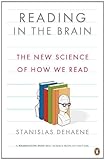1: https://www.amazon.com/Reading-Brain-New-Science-Read/dp/014...
Much of the best research on dyslexia is gathered into the very interesting recent book Reading in the Brain: The New Science of How We Read
http://readinginthebrain.pagesperso-orange.fr/intro.htm
http://www.amazon.com/Reading-Brain-The-Science-Read/dp/0143...
by Stanislas Dehaene. There are definitely educational approaches that help prevent the development of dyslexia in young readers or that alleviate it in older readers. Cross-national comparisons of reading in different scripts for differing languages, and comparisons of reading performance with differing typefaces for English (both reported on in the book) don't suggest that letter forms are the MAIN issue in dyslexia, although helping readers notice distinct letter shapes is helpful for readers who don't distinguish them. It would be a good idea to use the kind of brain-imagining studies mentioned by Dehaene (a neuroscientist) to test the usefulness of different fonts for readers who are categorized as having dyslexia.
As they say in Chinese, "實事求是" (the standard English translation is "seek truth from facts," which will do for this Hacker News comment), so whatever helps dyslexic persons, more power to it, but test to make sure how helpful it is and to find out what else would be helpful too.
http://www.kwintessential.co.uk/resources/global-etiquette/f...
Finnish, by far the majority language, has an alphabetic writing system that is recently reformed enough that it has very consistent sound-symbol correspondences.
http://www.omniglot.com/writing/finnish.htm
The late John DeFrancis
http://www.amazon.com/Visible-Speech-Diverse-Interactions-Co...
and current researcher and author Stanislas Dehaene
http://www.amazon.com/Reading-Brain-New-Science-Read/dp/0143...
develop historical and international comparisons, backed up by brain imaging in Dehaene's book, to make the argument that initial reading instruction should at its best focus students' attention to sound-symbol correspondences in the written language taught in primary reading instruction.
But initial reading instruction in the United States specifically and in English-speaking countries in general is only half-heartedly done that way,
http://learninfreedom.org/readseri.html
http://www.ncbi.nlm.nih.gov/pmc/articles/PMC3024599/
and when school pupils in English-speaking countries struggle to learn to read independently, they are also likely to struggle to learn other subjects thoroughly.
The best current information I have suggests that initial reading instruction in Finland, whether in Finnish or in Swedish, is better done than much reading instruction in the English-speaking world, and that advantage may account for much of the national advantage Finland enjoys (and partially explain why immigrant families who use Finnish as a second language are the bottom group found in national-level sample testing of Finland for international surveys).

